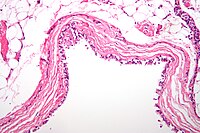
Photo from wikipedia
Abstract Background Hepatic cyst infection is a complication of polycystic liver disease (PLD) that causes substantial morbidity. Repetitive infection is frequent and is increasingly difficult to treat. As translocated gut… Click to show full abstract
Abstract Background Hepatic cyst infection is a complication of polycystic liver disease (PLD) that causes substantial morbidity. Repetitive infection is frequent and is increasingly difficult to treat. As translocated gut bacteria are considered the cause, we hypothesize that selective decontamination of the digestive tract (SDD) reduces recurrence of hepatic cyst infection. Methods We performed a retrospective, observational study in two referral centres. All patients with PLD treated with SDD for hepatic cyst infection were included. Efficacy was determined by calculating the infection incidence (hepatic cyst infections per month) before and during SDD therapy. Adverse events were scored according to the Common Terminology Criteria for Adverse Events (CTCAE). Results We identified eight patients who received SDD (88% female, 88% polycystic kidney disease). The median age was 65 years (IQR: 51–74 years). SDD lowered the median incidence from 0.09 episodes per month (IQR: 0.06–0.25 episodes per month) to 0.01 episodes per month (IQR: 0.00–0.05 episodes per month) (P = 0.12). Discontinuation of SDD led to rapid recurrence of cyst infection (71% within 6 weeks). SDD consisted of polymyxins with/without aminoglycosides. The median SDD treatment duration was 20 months (range: 3–89 months). Six patients (75%) developed adverse events [CTCAE Grade 1 (gastrointestinal: n = 3) or Grade 3 (ototoxicity: n = 1; fungal infection: n = 1)], mostly attributable to aminoglycosides; one patient developed polymyxin E resistance. Conclusions SDD prophylaxis provides a novel strategy for limiting recurrent hepatic cyst infection in PLD patients. However, adverse events are frequent and curtail its use. As most were attributable to aminoglycosides, polymyxin E is considered the preferred therapy.
Journal Title: Journal of Antimicrobial Chemotherapy
Year Published: 2020
Link to full text (if available)
Share on Social Media: Sign Up to like & get
recommendations!